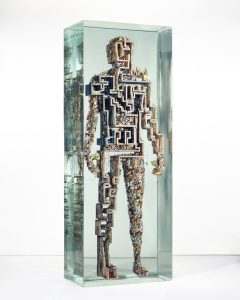Dustin Yellin is a sculptor that creates stunningly detailed and abstract visuals using a technique in which he sandwiches imaged between panes of glass in the general figure of a human. The exposition of 7-10 of these massive sculptures as presented in the large room initially give an eerie but comforting visual of seeing a group of people on display encased in a glass box. The bodies almost look as though they are part of an experiment, but open closer inspection, the arbitrary selection of collage cutouts does not appear to have any correlation with the remainder to the images.
Psychogeography 97 depicts a person who was drawn with what looks like an “etch-a-sketch” pattern from the head, through the torso and left arm, and down the right leg. The line is made of rows of windows from an apartment building, giving an industrial texture. The left leg, right arm, and the area around the window rows are covered in magazine cutouts of castles, beachballs, people, and many miscellaneous objects that overlap from pane to pane in order to make a human outline. Within the body, there are many different gatherings of people engaging in activities like jumping into a pool, climbing a rope from one row of windows to the other, and sitting around a fire. There is a tremendous amount going on.
This tedious process grants Dustin Yellin many artistic choices in order to display overlapping events in order to have a two-fold expression. On one hand, there is the detail of picking magazine cutouts that fit the right color, shape, size, texture, and on the other hand, there is the placement and location of the pieces that give the overall human figure that displays body language and emotion. Some of the other pieces have 2 heads, a sun for a head, a tear in the chest, but Psychogeography 97 has a rigid and confident stance. The choice of using epoxy and glass allows Yellin to add a three-dimensional element to what looks like a solid block of glass with a person stuck within.
The piece of art seems to discuss the relationship between the industrial world and humans. In this context, the industrial window setting is taking over our psychology and understanding of people, miscellaneous objects, and other people. The cluttered overlapping of objects also speaks to the state of disarray in cities. The careful compartmentalization of different elements through the person depicts not only our complex psychology as a human, as well as the many other elements to our lives that we separate our social, economic, personal, and more aspects of our life. The concept of having overlapping layers of images turn the piece into a multimedia representation of the many elements of being a person. The many individual experiences that we have cumulatively develop us to become who we are and the way we think. All in all, the cumulative emotion, shape, and texture allow Dustin Yellin to accurately and creatively express representation of human nature and our current state of togetherness.
